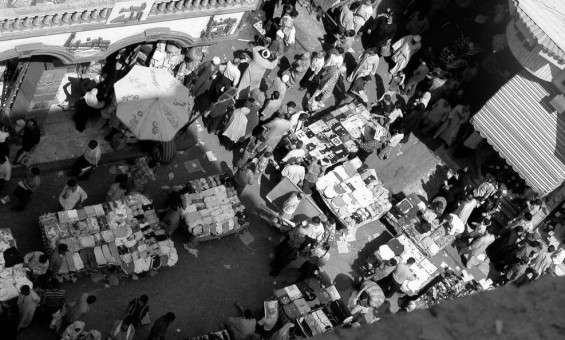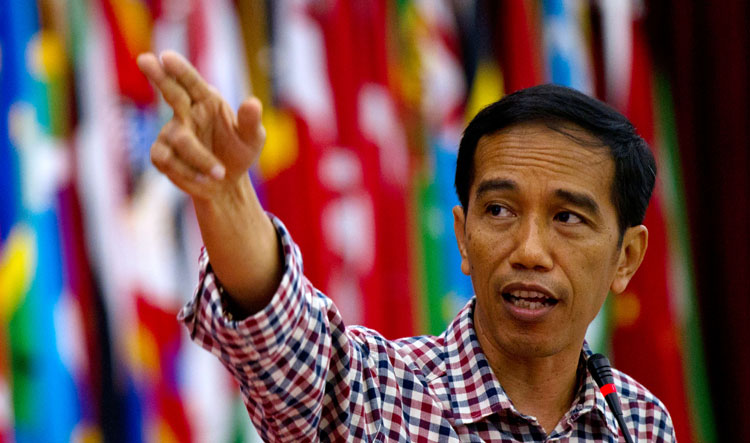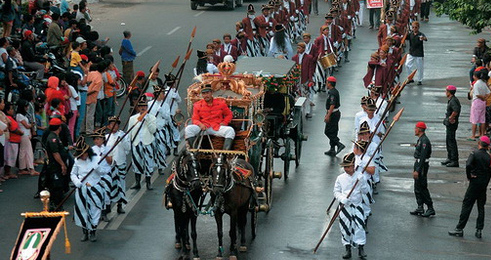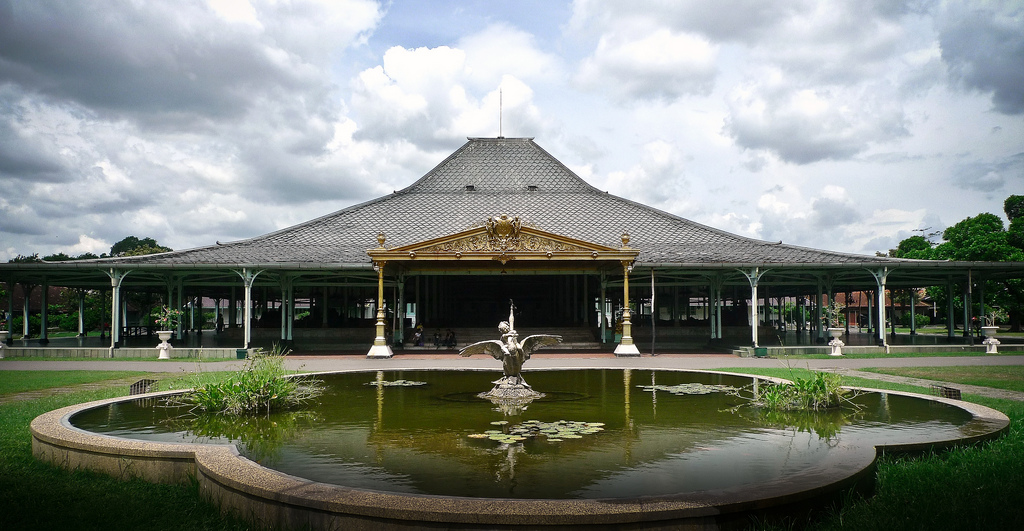
Dialogue, Negotiation, and Mutual Respect: An Indonesian Mayor’s Successful Approach to Relocating Street Vendors
Prior to the relocation effort, the government conducted a census of the street vendors working downtown. Eligible vendors were allegedly assigned spaces at al-Turjumān through a lottery system although it was unclear to the street vendors how permits were distributed. In an effort to appease the street vendors, Prime Minister Ibrahim Mehleb, the Minister of Industry, Commerce and Social Solidarity, and the governor of Cairo met with a group of street vendors three days after security forces began the relocation and promised to promote the new location through an advertising campaign.
When people imagine futures for any given space or area, they typically imagine a future that accommodates their needs, interests, and values. It is this conflict in these imagined spaces that ultimately drives the evolution of the built environment. In the conflict over street vendors in the public spaces of downtown Cairo, there are three primary groups involved with this conflict. First, are the government officials, planners, investors, and large property owners downtown who are imagining a revitalized downtown as an important Middle Eastern heritage area, a hotspot for international investment, a driver of Egypt’s economy, and a platform to bolster Cairo’s image on the global stage. They are following the model of cities like Mexico City, Mexico; Istanbul, Turkey; Mumbai, India; and New York, USA. An overabundance of street vendors does not fit into this vision. Instead, they see clean, wide tree-lined streets, with well-preserved buildings and an infrastructure to allow the easy access of downtown’s assets for tourists and make an attractive environment for major regional and international firms.
The second group is comprised of people who would be at risk of economic displacement should the intended investment of the government and large property owners take place: small property owners or shop-keepers, tenants, and residents of the downtown district. With the exception of property owners whose property value may increase with future investment, they lean toward a more conservative approach to their neighborhood. They would like to see some improvements in public space and tend to resent the excessive number of street vendors.
The third group is the street vendors themselves who use the public spaces of downtown to earn a basic living. The official unemployment rate stands at 13.4 percent and unofficial estimates are much higher. Street vending is a critical source of income for individuals who cannot find regular “formal” employment to support themselves or their families. Street vendors are part of Egypt’s informal sector, or any form of labor that is not taxed or regulated, which comprises 30 percent of national economy. In 2012, there were an estimated 4.5 million street vendors throughout the country and that figure has grown to approximately 6 million street vendors today. Street vendors depend foremost on foot-traffic to make sales and downtown provides some of the most frequented streets in all of Egypt.
Negotiating the use of public space can be difficult and contentious. When it comes to street vendors, many governments, from Kathmandu, Nepal to Blantyre, Malawi, ignore the needs, interests, and values of the street vendors themselves and use force to remove them. This security-first approach homogenizes differences in circumstances, activities and intentions of vendors and denies their voice in what should be a civic conversation about the use of public space. Instead of citizens, they are perceived and treated as threatening, obstructive, and criminal, particularly as compared to regulated, taxed, or “formal” retail and wholesale merchants and other economic actors.
But there is an alternative, less contentious approach that some cities are employing to resolve conflicts over the use of public space in general and with street vendors in particular. It is an approach based on dialogue and negotiation. The goal of the government remains the same: to remove street vendors and allow them to survive financially, but the means is a radical departure from the security approach employed by the Egyptian government. One notable example of this approach was in Surakata, Indonesia, better known as Solo, where Mayor Joko Widodo successfully relocated all of the street vendors from the city’s historic districts and more than 60 percent of the city’s total street vendors without using force.

Joko Widodo, mayor of Solo from 2005-2011, mayor of Jakarta from 2012-2014, president of Indonesia beginning October, 2014. Source: sylc.info
Decentralization and Making Elections
Joko Widodo was elected mayor of Solo in 2005. He was among Indonesia’s first democratically elected mayors following the fall of President Suharto’s 32 year-long military dictatorship (1966-1998). Like Egypt’s presidents past and present, Suharto ruled over a highly centralized government with a strong role for the military where there was no space for “alternative approaches” to local challenges. His regime limited the responsibilities of subnational levels of the government to implementing national policies. Suharto’s demise came in the wake of the 1997 Asian Financial crisis, where the Rupiah, the Indonesian currency, fell to one-sixth of its pre-crises value. Widespread protests, a crippled economy, and the loss of military support forced Suharto to resign in May of 1998.
In 1999, Indonesia embarked on an ambitious decentralization initiative. Following 32 years of military rule, calls for democratization were strong from all sectors of society and the reasons for decentralization were diverse. There were several active secessionist movements in various regions of the country that the central government believed could be appeased by allocating greater fiscal and political authority to regional governments. Some politicians lambasted the centralized regime for focusing most of the country’s investment on Jakarta, Indonesia’s capital, while enriching a small number of national politicians, creating regional resentment within the country. Others argued for decentralization as a way for the government to better identify the needs of the people at the local level, increase citizen participation in the government decision-making process, improve service delivery, reduce corruption, increase transparency, and hold politicians accountable (Buehler 2010).
Two laws promulgated in 2001 and amended in 2004, radically and immediately reshaped the roles, responsibilities, and relationship of the levels of government in Indonesia. The two laws and subsequent amendments decentralized nearly all government functions—with the exception of policing, justice, defense, and monetary policy—to cities and regencies.1
The laws also introduced new fiscal regulations in which local governments receive central government transfers as unallocated block grants, are entitled to a share in revenue derived from natural resources within the borders of the jurisdictions, and shared tax revenues (Bunnell et al 2013).
One of Indonesia’s 1999 laws on Regional Government stipulated that district chiefs, mayors, and governors were to be indirectly elected through local councils, where democratically elected local councils vote among themselves to appoint their executive. However, due to corruption at the local level, the central government adopted a law in 2005 that called for the direct election of these government officials, completing Indonesia’s “big bang” legislative transformation from a highly centralized state to a democracy in just six years (Buehhler 2010).
Joko Widodo and Solo’s Street Vendors
When Solo elected Joko Widodo as mayor, known by his nickname Jokowi, the city had a reputation for being volatile and was known locally as sumbu pendek or a city with a “short fuse.” For example, like other parts of the country during the 1997 Asian Crisis, residents of Solo protested against rising fuel prices, food shortages, and high levels of unemployment. However, the protests in Solo were among the most violent. Riots and mobs destroyed 330 businesses and 900 vehicles, most of which belonged to the ethnic minority Chinese. In 1999, after Indonesia’s first democratic presidential election, supporters of the losing presidential candidate burned down Solo’s City Hall. In 2002, the International Crisis Group published a report showing that Jemaah Islamiya, a Southeast Asian terrorist group with ties to Al-Qaeda, originated from Solo. Further, suspects in the 2002 and 2005 bombings in Bali and the 2003 Jakarta bombing also had connections to terrorist networks in the city (Majeed 2012).
In addition to the terrorist networks and political violence, Solo faced challenges that are all too familiar to Egyptian cities: low-quality and insufficient public services, extensive slums and informal areas, high unemployment, low levels of investment, deteriorating historic urban fabric, corruption, conflict among majority and minority religious and ethnic groups, lengthy bureaucratic registration processes for businesses and permitting processes for developers, and very tight budgets (Majeed 2012).
In addition to the terrorist networks and political violence, Solo faced challenges that are all too familiar to Egyptian cities: low-quality and insufficient public services, extensive slums and informal areas, high unemployment, low levels of investment, deteriorating historic urban fabric, corruption, conflict among majority and minority religious and ethnic groups, lengthy bureaucratic registration processes for businesses and permitting processes for developers, and very tight budgets (Majeed 2012).
Like President Abdul Fattah Al-Sisi’s goal for Egypt (and Cairo), Jokowi’s primary goal when he became mayor was to encourage economic growth and create job opportunities for residents, but Jokowi realized that he needed to settle longstanding problems first—such as the overabundance of street vendors in the city.
In 2005, there were about 6,000 street vendors in Solo. A high unemployment rate and insufficient opportunities for formal employment drove people to informal sources of income. Citizens blamed the street vendors for a loss of open space, increased traffic congestion, garbage on the streets and in parks, and for increased petty crime. Street vendors maintained that they were abused by police officers and government officials who threatened to force them from their place of businesses unless they paid regular bribes. Governments prior to Jokowi’s had tried to do something about the vendors but failed. They commissioned extensive studies on the issue, they attempted to forcibly remove the vendors and build modern shopping centers on the traditional market sites, but the street vendors resisted and their numbers continued to grow.
Jokowi’s first target was the historic Banjarsari monument park where about 1,000 vendors worked. He announced that he would remove the street vendors from the park by August 17, Indonesia’s Independence Day, soon after assuming office in 2005. The street vendors protested openly holding banners that read, “Struggle until the end of our life. We would rather die than move.” Jokowi wasn’t interested in lighting the short fuse of Solo in his first months in office, so rather than force the relocation he took a different tack.
Over the next six months, Jokowi held 104 meetings with the street vendors to hear and address their concerns and come to an agreement (Bunnell et al. 2013). University researchers gathered information about the street vendors including the number of vendors, the size of their stalls, and the types of goods they sold so he could better understand their situation and the challenges they faced. Through the dialogue with vendors and data collected by researchers, Jokowi pledged to build suitable stalls at an alternative site four kilometers from Banjarsari Park and to provide public transportation to the new area. He also agreed to publicize the location through a marketing campaign. He offered vendors incentives to move such as free licenses, carts, umbrellas, tents and kiosks, as well as education and training sessions. He agreed to exempt the sellers from taxes in their first six months in the new marketplace and created a program to provide affordable loans to the sellers for the transition. By December 2005, all 989 of the street vendors working in Banjarsari agreed to move, and by July 2006, the new marketplace was completed (Majeed 2012). The 11,000 square meter marketplace was designed by a local university and cost the government approximately USD 1 million and could accommodate more than 1,000 vendors (Inclusive Cities Observatory, no date).
Jokowi understood that the street vendors are an integral part of the city’s economy and that street vending was a vital source of income for many families in Solo. Negative impacts on their income would only add the poverty and hardship of the population. He also understood the economic benefits to the city of ensuring that the vendors could preserve their income. Through taxes and rents on the street vendors, he calculated that it would take just seven years to recover the full costs of the relocation (Majeed 2012).
The street vendors relocated from Banjarsari Park to the new marketplace in a traditional procession. The procession was a show of support from the community and government to the street vendors, honoring their role in society. The procession included Jokowi and his deputy mayor, the street vendors, local government officials, community leaders, NGO activists, marching bands from local schools, and soldiers. Jokowi built on his success with the vendors at Banjarsari Park and worked with other vendors in other neighborhoods to negotiate their relocation. By 2011, 3,711 of the original 5,817 street vendors from the 2005 survey were relocated to centralized market places in Solo (Bunnel, et al. 2013).

Traditional procession in Solo to relocate street vendors to their new location. Credit: www.apakaradunia.com
Larger Reform
Jokowi’s efforts to relocate the street vendors were part of a series of reforms to revitalize Solo, reinvigorate the economy, and reshape its public image both nationally and internationally. He revived a 2003 marketing strategy for the city called, “Solo: The Spirit of Java” and took steps to leverage Solo’s cultural and built heritage to attract international investment and tourism. Jokowi streamlined registration and licensing processes in the city, reformed the bureaucracy and cracked down on the corruption and rent-seeking behavior that crippled the efficiency and effectiveness of government services.

Mangkunegaran Palace in Solo, Indonesia. As the seat of two rival kingdoms in the 18th and 19th centuries, Solo is a hub of Javanese culture and built heritage. Jokowi used this heritage to spur economic development and establish Solo as an international tourist destination. Source: Radiansyah, Flickr.
Of course Jokowi did not do any of this alone. He worked closely with his deputy mayor, F.X. Hadi Rudyatmo, a seasoned politician with a great deal of grassroots and implementation experience as well as an extensive staff. Jokowi and Rudyatmo complemented one another well: Jokowi created the greater vision for Solo and Rudyatmo implemented the plans. They also ensured that their entire staff was engaged in their vision. They did not tackle one problem at a time, but worked on education, health, economic development, and urban planning all at once, realizing that all of the reforms necessary for revitalizing Solo were interlinked.
As the street vendor example shows, openness and dialogue were an important part of Jokowi’s governing approach. From his previous career as a businessman, he understood the importance of the business community’s support to be successful. He held regular, informal meetings with business people to better understand their needs. He also adopted a very open, form of leadership to strengthen his ties to communities throughout the city. Each week the mayor, vice mayor, and department heads visited different neighborhoods to assess government services and encourage civil servants to fix problems they saw. In order to keep pressure on his staff and hold them accountable, he distributed his mobile number to residents as a 24-hour complaint hotline (Majeed 2012).
Jokowi was also an advocate of the right of citizens to access information. For example, in 2009, Mayor Jokowi supported an initiative of local university students to survey and map all 51 neighborhoods in Solo. The information gathered through the project, Solo Kota Kita, is now available online for anyone to access through an interactive map. Information includes poverty levels, household access to water and sanitation, percentage of uninhabitable homes and the location of schools, hospitals, and open space.

Solo Kota Kita’s homepage showing an interactive map that displays information about each of Solo’s neighborhoods.
Conclusion
Jokowi’s rapid ascent through Indonesia’s political system demonstrates the success of his governing style and the desire of Indonesians for an open, transparent, and accessible leader. Jokowi’s appeal to many Indonesians was his humble origins and the fact that he was a political outsider untainted by corruption. Unlike other political elites, Indonesians could relate to him. Jokowi was born in Solo and lived in a poor, riverside neighborhood. He ran a furniture exporting business for nearly 20 years before joining the Indonesian Democratic Party of Struggle (PDI-P) in 2004. Still relatively unknown in the 2005 contest for mayor of Solo, Jokowi won with just 36 percent of the vote. In 2010, he was re-elected as mayor in a landslide victory, garnering more than 90 percent of the vote. Jokowi’s widespread popularity in his hometown caught the attention of the leaders of his party who nominated him for the 2012 gubernatorial election of Jakarta, Indonesia’s capital. He resigned as mayor of Solo for the Jakarta election and, despite being an outsider to the city, he defeated the incumbent mayor easily. In 2014, his improbable rise to power was completed when the PDI-P nominated him for the presidential election. In 2014 he won a heavily contested election, becoming Indonesia’s first president to emerge from outside the political elite or the military.
But Solo is where his story began and Solo is where he learned to govern. As mayor, Joko Widodo took full advantage of the authority and responsibilities given to local government executives in the decentralization legislation from 1999 and 2004. He had the legislative, financial, and administrative authority to innovate and solve some of Solo’s most difficult challenges, and he demonstrated the effectiveness of negotiation and dialogue as a tool to govern. Jokowi did not have to contend with undue pressure from the central government to adhere to their policies and had the freedom to allocate funds as he needed for social and economic development programs. As a representative of the people, he worked closely with all sectors of society to understand their needs and worked on their behalf to improve public services and the civil service.
Unfortunately, Egyptian subnational executives do not have the freedom to undertake programs similar to those of Jokowi. As appointed officials, Egyptian executives are ideologically aligned with the central government, which, as was the case with removing street vendors, places security above all other concerns. They are limited in their ability to engage in meaningful dialogue with their constituencies because they are ultimately accountable to the President and Prime Minister. Without decentralization or the ability of citizens to elect mayors as the executive of their city or region, there is little possibility of a pragmatic, open, and accommodating government in Egypt that serves the needs of its people. Yet, it is important to remember that the new President of Indonesia’s path to power began with legislative change that allowed significant autonomy at the local level and new political leaders to emerge after proving their administrative and political skills while in office. Unfortunately, Indonesia’s political revitalization is also coming undone through legislative change since one of the outgoing national parliament’s last acts as a legislative body in September 2014 was to change the rules of electing mayors and other local government representatives. Indonesian mayors are no longer directly elected by the people, but are once again indirectly elected by municipal councils. However, one wonders what reforms and initiatives Jokowi will bring to the country as the new president of Indonesia.
Works Cited
Buehler, Michael. 2013. Decentralization and Local Democracy in Indonesia: The Marginalisation of the Public Sphere. In Problems of Democratisation in Indonesia: Elections, Institutions, and Society. Eds. Aspinall, Edward and Marcus Mietzner. Institute of South East Asian Studies Publishing, Singapore.
Bunnell, Tim, Michelle Ann Miller, Nicholas A. Phelps, and John Taylor. 2013. “Urban Development in a Decentralized Indonesia: Two Success Stories?” Pacific Affairs 86:4, 857-876.
Inclusive Cities Observatory. No date. “Surakarta Indonesia: Empowering the Informal Sector: Street Vendor Management.” UCLG Committee on Social Inclusion, Participatory Democracy, and Human Rights. Accessed 10 October 2014. http://www.uclg-cisdp.org/sites/default/files/Surakarta_2010_en_final.pdf
Majeed, Rushda. 2012. “Defusing a Volatile City, Igniting Reforms: Joko Widodo and Surakarta, Indonesia, 2005-2011.” Innovations for Successful Societies. Princeton University.
1. In Egypt, cities would be the equivalent of the four urban governorates, Cairo, Alexandria, Port Said, and Suez, or the capital cities of the remaining 24 governorates. Regencies are equivalent to the marakez, or regional subdivisions of mixed urban and rural governorates.
Featured Image by usbpanasonic on Flickr.









Comments